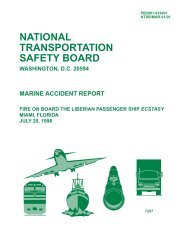Soot Deposits and Fires in Exhaust Gas Boiler - Martin's Marine ...
Soot Deposits and Fires in Exhaust Gas Boiler - Martin's Marine ...
Soot Deposits and Fires in Exhaust Gas Boiler - Martin's Marine ...
- No tags were found...
Create successful ePaper yourself
Turn your PDF publications into a flip-book with our unique Google optimized e-Paper software.
In general, the particles are small <strong>and</strong>,when the eng<strong>in</strong>e operates on heavy fueloil, it may be expected that over 90%of them will be less than 1 micron <strong>in</strong> size,exclud<strong>in</strong>g flakes of deposits, <strong>and</strong> peel<strong>in</strong>g-offfrom the combustion chamber orexhaust system walls.The particulates also <strong>in</strong>clude some ofthe ash content of the oil, i.e. the tracemetals. The above-mentioned contributionfrom the lubricat<strong>in</strong>g oil consistsma<strong>in</strong>ly of calcium compounds, viz.sulphates <strong>and</strong> carbonates, as calciumis the ma<strong>in</strong> carrier of alkal<strong>in</strong>ity <strong>in</strong> lube oilto neutralise sulphuric acid.A test of the soot deposits <strong>in</strong> a boilerwith gilled tubes has shown that about70% of the soot is combustible.HydrocarbonsDur<strong>in</strong>g the combustion process, a verysmall part of the hydrocarbons will leavethe eng<strong>in</strong>e unburnt, <strong>and</strong> others will beformed. These are referred to as unburnthydrocarbons, <strong>and</strong> they are normallystated <strong>in</strong> terms of equivalent CH 4content.The content of unburnt hydrocarbons <strong>in</strong>the exhaust gas from large diesel eng<strong>in</strong>escan be up to 300 ppm, but depends,among other factors, very much on thema<strong>in</strong>tenance condition of the fuel <strong>in</strong>jectionsystem <strong>and</strong>, to some extent, on thetype of fuel <strong>and</strong> the cyl<strong>in</strong>der oil dosage.The hydrocarbon figure to some extentoverlaps the figure for particulates, asthese consist partly of hydrocarbons.Sticky effect of particulate emissionsIf the right – or rather the wrong – conditionsprevail, the soot particulatesmay deposit <strong>in</strong> the exhaust gas boiler.Furthermore, the lower the exhaust gas<strong>and</strong> heat<strong>in</strong>g surface temperatures become,the faster the soot is deposited<strong>and</strong> the harder it becomes to remove it.The explanation is that under such conditionsthe soot may be “wet” with oil<strong>and</strong>/or other gas condensates like hydrocarbons,<strong>and</strong> this may have an <strong>in</strong>creas<strong>in</strong>geffect on the tendency of soot todeposit, as the soot may be more sticky.<strong>Soot</strong> fires <strong>in</strong> exhaust gas boilersA fire <strong>in</strong> the exhaust gas boiler may develop<strong>in</strong> two or three stages, see Fig.15 <strong>and</strong> Ref. [2]. The ignition of soot normallydevelops <strong>in</strong>to a small <strong>and</strong> limitedfire, but under extreme conditions itmay develop <strong>in</strong>to a high-temperature fire.Ignition of sootIgnition of soot may arise <strong>in</strong> the presenceof sufficient oxygen when the depositsof combustible materials have a sufficientlyhigh temperature (higher thanthe flash po<strong>in</strong>t) at which they will liberatesufficient vapour, which may be ignitedby a spark or a flame.The ma<strong>in</strong> constituent of the soot depositis particulates but, <strong>in</strong> addition, someunburnt residues of fuel <strong>and</strong> lubricat<strong>in</strong>goils may be deposited <strong>in</strong> the boiler becauseof faulty combustion equipment<strong>and</strong>, <strong>in</strong> particular, <strong>in</strong> connection withstart<strong>in</strong>g <strong>and</strong> low speed runn<strong>in</strong>g of theeng<strong>in</strong>e.The potential ignition temperature of thesoot layer is normally <strong>in</strong> the region of300-400 o C, but the presence of unburntoil may lower the ignition temperatureto approx. 150 o C, <strong>and</strong> under extremeconditions even down to 120 o C.This means that ignition may also takeplace after stop of the ma<strong>in</strong> eng<strong>in</strong>e asa result of glow<strong>in</strong>g particles (sparks)rema<strong>in</strong><strong>in</strong>g on the boiler tubes.Small soot firesSmall soot fires <strong>in</strong> the boiler are mostlikely to occur dur<strong>in</strong>g manoeuvr<strong>in</strong>g withthe ma<strong>in</strong> eng<strong>in</strong>e <strong>in</strong> low load operation.These fires do not cause damage tothe boiler, or damage is very limited, butthe fires should be carefully monitored.Heat from the fire is ma<strong>in</strong>ly conductedaway with the circulation water <strong>and</strong>steam <strong>and</strong> with the combustion gases.High-temperature firesUnder certa<strong>in</strong> conditions, a small sootfire may develop <strong>in</strong>to a high-temperaturefire. The photo <strong>in</strong> Fig. 16 shows anexample of an exhaust gas boiler whichhas had a high-temperature fire, wherethe boiler tubes have burned <strong>and</strong> melted.The reactions <strong>in</strong>volved here are (see alsostage 3 <strong>in</strong> Fig.15).a. Hydrogen fireThis occurs because dissociation ofwater <strong>in</strong>to hydrogen <strong>and</strong> oxygen or, <strong>in</strong>connection with carbon, <strong>in</strong>to carbonmonoxide <strong>and</strong> hydrogen, may occurunder certa<strong>in</strong> conditions. A hydrogenfire may start if the temperature isabove 1000 o C.b. Iron fireAn iron fire means that the oxidationof iron at high temperatures occurs ata rate sufficiently high to make theamount of heat release from the reactionssusta<strong>in</strong> the process. Thesereactions may take place at a temperature<strong>in</strong> excess of 1100 o C.In this connection, it is important torealise that also water (H 2O) may go<strong>in</strong> chemical reaction with iron (Fe),i.e. the use of the steam based sootblower will feed the fire.This document, <strong>and</strong> more, is available for download at Mart<strong>in</strong>'s Mar<strong>in</strong>e Eng<strong>in</strong>eer<strong>in</strong>g Page - www.dieselduck.net13
















